

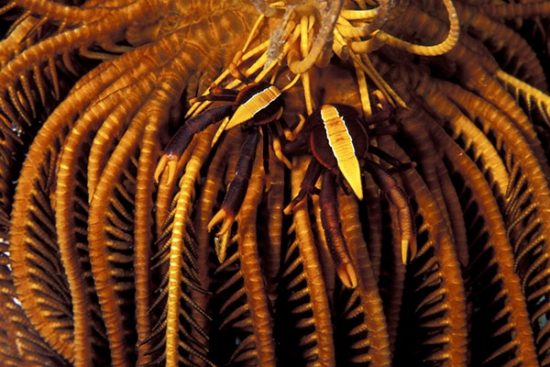
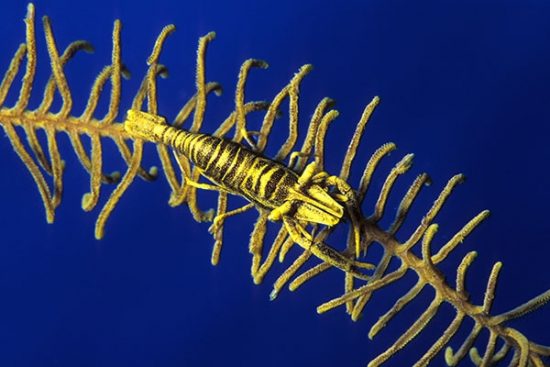
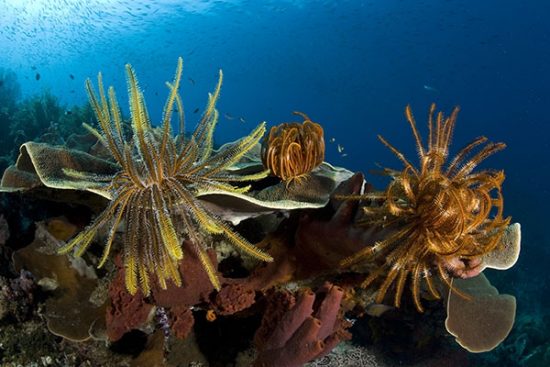

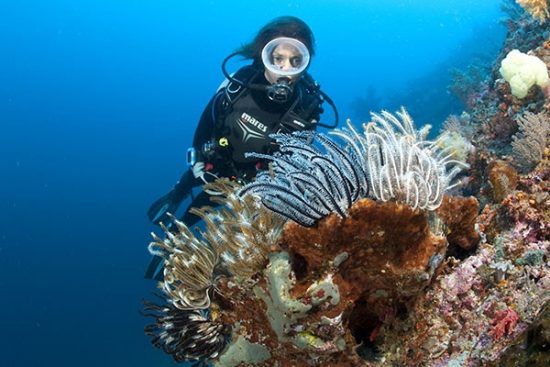
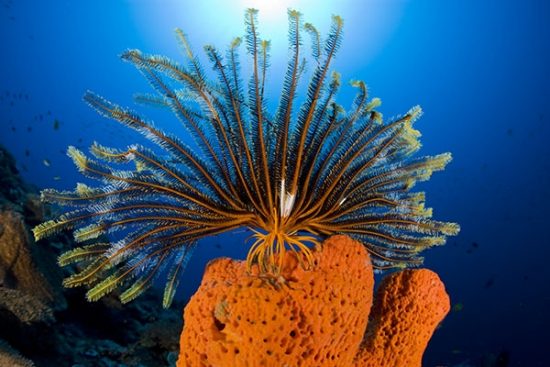
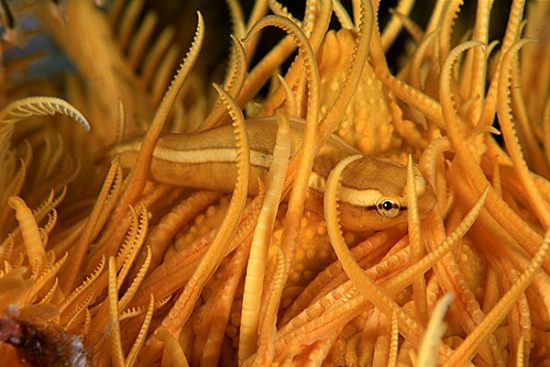

One of the things that struck me most during the first dives I made in Papua New Guinea, and especially the underwater reefs around Walindi, was the number of crinoids I found. These animals, which resemble large flowers with yellow, red, black or striped corollas, are to be found scattered throughout the reef or attached to hard corals, sponges and gorgonian sea fans.
I watched them and began to take photographs, fascinated by new colours or particular positions. My curiosity led me to study them further, and I discovered another world of small animals like shrimps, crabs and little fish which live inside the crinoid. These guests are so small and are such expert mimics that they can only be seen following long, attentive observation.
Crinoids belong to the Echinoderms family. This big group is divided in two subclasses which have a similar anatomy, but their biological uses are completely different: sea lilies and feather stars. Sea lilies are essentially deep water forms, living predominantly at depths from 500 to 8000 metres. Feather stars live at depths which are more accessible to recreational divers, attached to corals, sea fans and sponges, in a position exposed to the current, where they extend their long arms to catch food transported by the water.
Like all members of the Echinoderms family, crinoids have a radial symmetry, with many arms branching out from a central disk. If they are compared to starfish, sea-cucumbers, sea-urchins and brittle stars, which all belong to the same family, one main difference becomes clear: their way of feeding. Crinoids filter the water, while the others find nourishment from the sea bed.
The number of arms, from five to two hundred, varies depending on the species. The ones most frequently encountered on reefs have between ten and forty arms. Also, crinoids can lose some of their arms in order to escape predators. This is a common behaviour of the Echinoderms family, and sea stars use this technique very often. A feather star can lose four of its five arms. The animal can reproduce these parts in less than twenty days. Every arm has small ciliums, called pinnules, which give the animal a feathery aspect. The ciliums are covered by a sticky substance which helps the crinoid capture food, plankton etc. which is then brought to the animal’s mouth.
The dense forest formed by the arms of the crinoid gives shelter to other small animals: small shrimps, crabs and fish rightly feel safe because crinoids are one of the few types of animals which do not have enemies, because they taste so bad - if a predator tries to eat one, it will usually spit it out disgusted. Although attacks on crinoids are not so common, if they do occur they are usually limited to a removed arm which is quickly regenerated.
There are some fish that have been seen to feed on crinoids, and in the stomachs of other fish, the remains of crinoids have been found, including some wrasses, butterfly, puffer fish, but the triggerfish (Balistoides conspicillum) is the most popular predator, it seems they like to break their structure and crunch the crinoids. Fish or other animals rarely eat crinoids because their body is formed of a limestone skeleton covered by a thin layer of tissue.
The night life of crinoids is often seen to be a defence against predators. At night, there is more food available: the animals which form zooplankton rise to the surface, and the small animals living in the crinoids, sheltering in its arms, take this chance to feed in safety. At first sight, these animals are difficult to see, because they are so small and they blend in perfectly with the colours of the crinoid. For example, the small harlequin ghost (Solenostomus paradoxus) fish lives in complete peace in a crinoid, because it is the same colours (red, white and black) and has the same designs. Also the small crinoid clingfish (Discotrema crinophila), just 2-3 centimetres long, uses a suction pad under its abdomen to attach itself to the arms of the central body of the crinoid. Shrimps such as the Periclemenes djiboutensis and the Periclemenes tenuis, the squat lobsters, take the food that the crinoid’s arms transport to its mouth through the tendrils. All these little guests have to do is wait and intercept the food before the crinoid swallows it. This little “theft” does not greatly affect the crinoid’s eating habits. If it does not get enough to eat, all it does is move off to a better position where it can capture more organisms.
With a bit of luck, they can be seen gracefully swimming towards a new anchoring point. I once found myself near a group of crinoids and I felt them attacking my leg and arm: they must have mistaken me for a sponge or a gorgonian sea fan. In Papua New Guinea, this event is not rare, given the number of crinoids you can find there.
 Franco and Sabrina
Franco and Sabrina 14th June 2021
14th June 2021